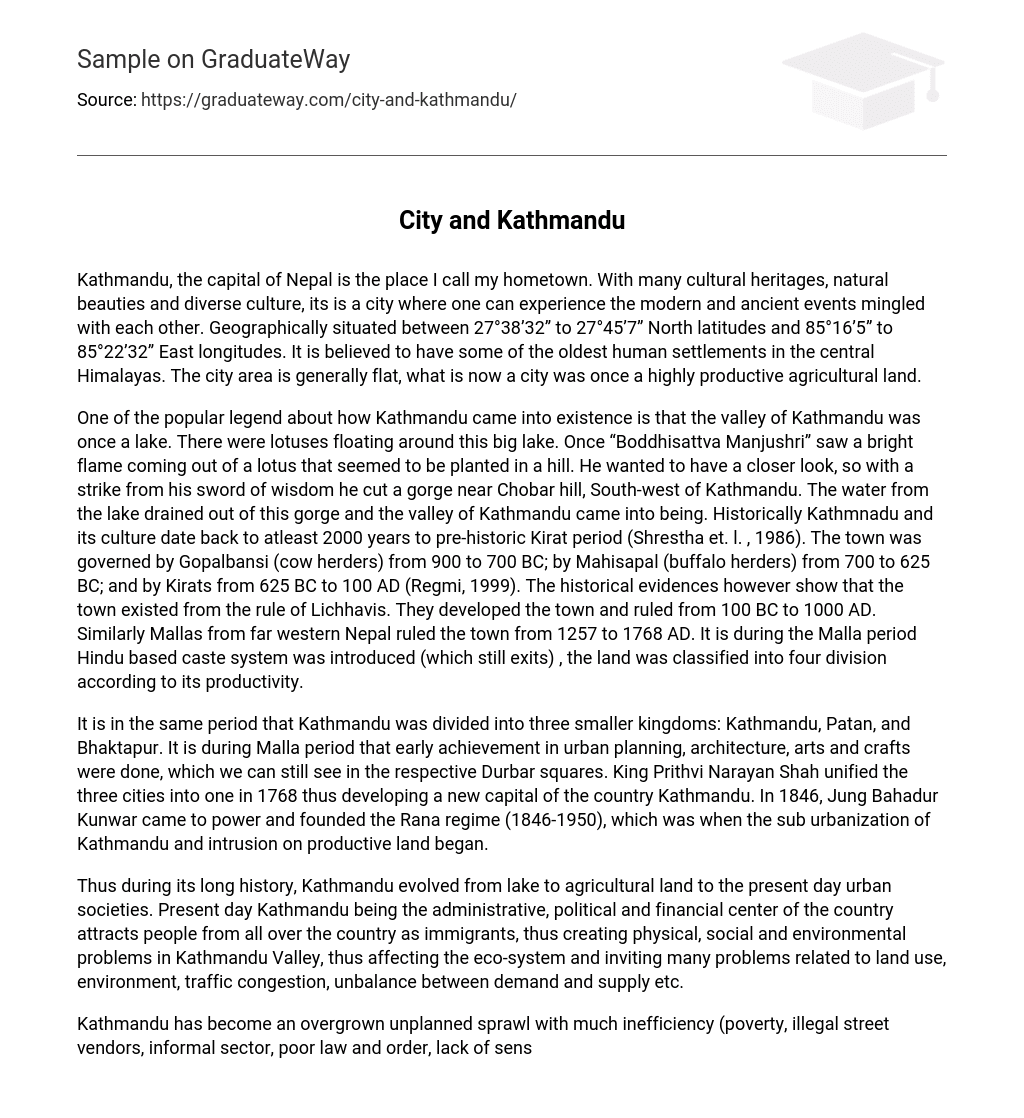Kathmandu is a city that blends modernity with ancient traditions. It showcases its cultural heritage, breathtaking natural landscapes, and diverse culture. Geographically, Kathmandu is located between 27°38’32” to 27°45’7” North latitudes and 85°16’5” to 85°22’32” East longitudes. This area in the Himalayas has been inhabited by humans for many generations. Despite now being mostly flat, Kathmandu was previously fertile farmland.
Legend has it that Kathmandu, once a lake with lotuses floating about, originated from a bright flame emerging from a lotus on a hill. Boddhisattva Manjushri, curious about the flame, used his sword of wisdom to cut a gorge near Chobar hill in southwest Kathmandu. This caused the lake water to drain out and give rise to the Kathmandu valley.
In terms of history and culture, Kathmandu can be traced back at least 2000 years to the pre-historic Kirat period (Shrestha et. al., 1986). The town went through various phases of governance: Gopalbansi (cow herders) from 900 to 700 BC, Mahisapal (buffalo herders) from 700 to 625 BC, and then the Kirats from 625 BC to 100 AD (Regmi, 1999).
However, historical evidence indicates that Kathmandu truly thrived under the rule of the Lichhavis from 100 BC to 1000 AD. During this time, they developed the town and reigned over it. Following them were the Mallas from western Nepal who ruled Kathmandu between1257 and1768 AD. It was during their reign that the Hindu-based caste system was introduced and land was categorized into four divisions based on productivity.
During the Malla period, Kathmandu was divided into three smaller kingdoms: Kathmandu, Patan, and Bhaktapur. This period also saw advancements in urban planning, architecture, and arts and crafts, which can still be observed in the respective Durbar squares. In 1768, King Prithvi Narayan Shah unified the three cities into one, establishing Kathmandu as the new capital of the country. The Rana regime was founded by Jung Bahadur Kunwar in 1846 and lasted until 1950, a period characterized by sub urbanization of Kathmandu and encroachment on productive land.
Kathmandu has experienced multiple transformations throughout its history. It evolved from being a lake to becoming farmland and eventually developed into the urban communities we witness today. As the main center for administration, politics, and finance in the nation, present-day Kathmandu draws immigrants from diverse backgrounds. This results in various challenges concerning physical, social, and environmental aspects within the Kathmandu Valley. These problems impact the ecosystem and contribute to issues related to land use, environment, traffic congestion, as well as imbalances between supply and demand.
The city of Kathmandu has undergone a transformation, becoming disorderly and chaotic due to various issues. These include poverty, illegal street vendors, a thriving informal sector, weak law enforcement, lack of community unity, inadequate infrastructure, inefficient public transportation with poor connectivity, substandard and unsafe housing, water and electricity shortages, and ineffective waste management. In order to become a modern metropolis, Kathmandu must confront these challenges directly. The primary concerns revolve around transportation, water supply and sanitation, as well as environmental considerations. These are just a few examples of the prominent difficulties faced by Kathmandu.
Transportation in Kathmandu relies mostly on roadways as the country doesn’t have railway connections due to being landlocked. Nevertheless, the city faces significant issues with its road infrastructure. Insufficient parking facilities and a variety of vehicles, combined with problems like reckless driving, improper parking, and roadside trading, lead to traffic congestion on the narrow and winding urban roads. Although attempts have been made to widen certain areas through urban planning, the execution has been ineffective, worsening the problem rather than solving it.
The Environmental and waste management issue in Kathmandu is a major concern. The city’s uncontrolled urbanization, lack of government oversight over random industrial units, and disorganized disposal of human waste have resulted in significant environmental problems related to air, water, and land. Common occurrences include the illegal dumping of waste in public areas and river banks. Day by day, land pollution increases due to the absence of a well-managed sewage and solid waste management system. One potential solution is utilizing these waste materials for alternative energy production, which would not only prevent environmental deterioration but also generate alternative energy sources. Additionally, this approach could incentivize individuals to manage solid waste at the household level, ultimately resolving long-term waste management issues.
In the last decade, various significant planning initiatives have been undertaken by the government with a focus on the Kathmandu valley. An example is the publication of ‘Environment Planning and Management of the Kathmandu Valley’ in 1999, which analyzed existing ecological and environmental problems within the metropolitan region while exploring options to limit growth through creating secondary adjoining towns (IUCN, 1999).
The text suggests various policies for urban land use development. These policies include discouraging urban development in agriculturally productive areas, river banks, terrace edges, ecologically hazardous zones, and areas lacking basic infrastructures and urban facilities. Additionally, the text recommends planning and developing ‘eco-towns’ in the metropolitan region, improving transportation networks, modifying the existing sewerage system, and rehabilitating degrading and collapsing traditional settlements in the city.
The improvement of transportation, solid waste management, and environmental issues will not only enhance Kathmandu as an urbanized city but also contribute to its economic and social growth. By focusing on efficient urban development strategies and land use planning, Kathmandu can reveal numerous other opportunities that are currently overshadowed by the city’s many challenges. Therefore, through political stability, well-thought-out government policies, and successful implementation of these policies and plans, Kathmandu can move towards sustainable development.





